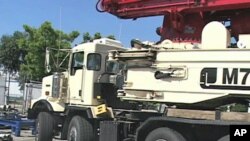Two giant pumps normally used for concrete in construction projects will soon be used to help cool nuclear reactors in Japan. In a few days, they will be loaded onto planes originally designed to carry the Russian Space Shuttle and flown from the U.S. to Japan to be deployed at the damaged Fukushima nuclear plant.
The world’s largest boom pumps are normally used to carry concrete in large construction projects. But two of these giant pumps, made by the German firm Putzmeister, will soon travel from the U.S. to Japan, for a very different purpose.
"It’s going to be pumping fresh water to the cooling ponds to start," said Gary Schmidt.
Putzmeister Manager Gary Schmidt says smaller pumps have already been spraying water onto the damaged reactors to keep them from overheating. But a giant pump with a 70-meter vertical reach, or 25 stories high, can spray 160,000 liters of water every hour. It can also do what the other pumps cannot.
"It helps to get over any obstructions and in," he said. "So, it will reach up and back into the building."
Engineering professor Ivan Catton says having a bigger pump with a longer reach will be more accurate than existing pumps at the reactors.
"What you see is a fire truck with an extended nozzle spraying over the edge - you really don’t have a clue where it’s going," said Catton. "They just hope they’re getting it on top of the spent fuel pool. If they have this one, with an extended boom, you can put a video camera up there, and you could put it right where you want it..."
The crisis in Japan is not the first time Putzmeister has dealt with a nuclear disaster.
"We provided the concrete pumping equipment for Chernobyl," said Schmidt.
But unlike Chernobyl in Ukraine, where the plant has been sealed in concrete, Catton says the damaged reactors in Japan can and should be studied when they are safer several years from now.
"You need to dissect this beast, and figure out exactly what went on in order to avoid it in the future," he said.
In the meantime, Catton says the best hope for the Fukushima nuclear disaster is to keep pouring water onto the reactors, find and repair the problems and wait for the situation to improve.












